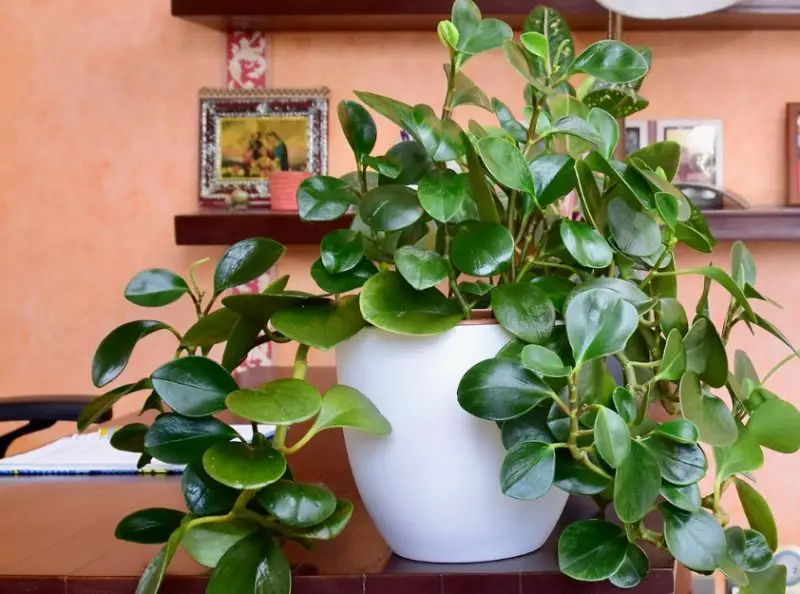The Baby Rubber Plant (Peperomia obtusifolia) is a beloved choice for both novice and experienced plant enthusiasts, thanks to its attractive foliage, low maintenance requirements, and resilience. With its thick, glossy leaves and compact growth habit, this perennial plant not only enhances indoor spaces but also purifies the air.
In this comprehensive care and growing guide, we’ll explore everything you need to know to cultivate a thriving baby rubber plant, from ideal light and watering conditions to soil preferences and common pest management.
About Baby Rubber Plant

The Baby Rubber Plant (Peperomia obtusifolia), also known as the pepper face plant, is a popular perennial houseplant belonging to the Piperaceae family. This herbaceous plant is admired for its thick, glossy, oval-shaped leaves that store water, making it relatively drought-tolerant. The baby rubber plant typically grows up to 1 foot tall, making it an ideal choice for small indoor spaces.
Native to South America, this plant thrives in environments with partial sun exposure, preferring indirect light. It is adaptable to various soil types, including clay, sand, and loam, and can tolerate a wide range of soil pH levels, from acidic to alkaline. Although the baby rubber plant is primarily cultivated for its attractive foliage, it may produce small, inconspicuous white flowers during its blooming season, which can occur throughout the spring, summer, fall, and winter.
The plant is hardy in USDA zones 10-12, meaning it prefers warm, tropical climates but can also thrive as an indoor plant in cooler regions. Known for its low maintenance and resilience, the baby rubber plant is an excellent choice for both beginner and experienced plant enthusiasts.
Baby Rubber Plant Care
To care for a Baby Rubber Plant (Peperomia obtusifolia), start by selecting an indoor spot with bright but indirect light. For non-variegated varieties, they can tolerate low light conditions, making them ideal for spaces with less natural light. One of the most important aspects of care is to avoid overwatering, as baby rubber plants are sensitive to soggy or overly wet soil. Let the top inch of soil dry out between waterings to prevent root rot.
These plants also thrive in environments with higher humidity, so placing them in a humid room, such as a bathroom or kitchen, is ideal. Keep the temperature in the range of 65°F to 75°F, as they are not cold-hardy. During the growing season, typically in spring and summer, apply a balanced fertilizer once a month to encourage healthy growth.
Light
When it comes to light requirements, keeping your Peperomia obtusifolia out of prolonged, intense sunlight is crucial. Excessive exposure to direct sun can lead to leaf burn, causing damage to the plant’s thick, fleshy leaves. Additionally, for variegated cultivars, too much direct sunlight may result in the fading of their distinctive coloration, diminishing their aesthetic appeal. A partially shaded spot near a south, east, or west-facing window is ideal, as it allows the plant to receive enough light without being exposed to harsh, direct afternoon sunlight, which can be too intense.
On the other hand, non-variegated cultivars are more adaptable to low-light conditions. While they can thrive in dimmer areas, providing them with some bright, early morning sunlight will promote healthier growth and help maintain their vibrancy. In general, ensuring the right balance of indirect light is key to keeping your baby rubber plant healthy and lush.
Soil
When it comes to soil, baby rubber plants thrive in moist conditions, but as epiphytic species, they are sensitive to standing water, which can cause root rot. Therefore, it’s essential to use a well-draining medium. Although the plant isn’t particularly picky about the type of soil, it does best in a loose, fertile potting mix that allows excess water to drain away easily. A good mix for the plant consists of 2 parts peat and 1 part perlite or sand, which helps retain some moisture while preventing the roots from sitting in water. This balance is key to keeping your baby rubber plant healthy.
Water
For watering, baby rubber plants require moderate watering during the growing season, typically about once every one to two weeks. It’s important to let the top few inches of the potting mix dry out before watering again to avoid overwatering.
During the winter months, the plant’s water needs decrease, so you should allow the soil to dry out more between waterings. While the leaves store moisture and the plant exhibits some drought tolerance, leaving it too dry for extended periods can negatively impact the growth and health of the foliage. To ensure your plant remains vibrant, avoid letting the soil stay dry for too long on a regular basis.
Temperature and Humidity
Baby rubber plants thrive in temperatures ranging from 65°F to 75°F, making it ideal for warm, humid environments like a bright, steamy bathroom. If the temperature in your home frequently drops below 50°F, this plant may struggle, as it is sensitive to cold and does not tolerate chilly conditions well.
To ensure optimal health, keep your baby rubber plant away from blasts of heat, air conditioning units, and drafty windows, as sudden temperature fluctuations or dry air can stress the plant. If you’re not able to place the plant in a naturally humid room, consider increasing humidity by misting the leaves or using a pebble tray filled with water beneath the pot. This is especially beneficial during the active growth period in summer, when the plant’s need for moisture is higher.
Fertilizer
The baby rubber plant has small, epiphytic roots and doesn’t require heavy feeding. However, to promote healthy foliage growth, applying a diluted all-purpose liquid fertilizer once or twice a month during the growing season (spring and summer) is beneficial. Make sure not to over-fertilize, as the plant’s roots are sensitive, and too much fertilizer can lead to salt buildup in the soil, affecting its overall health. Regular, light feeding is enough to keep the plant thriving.
Pruning
The baby rubber plant has a naturally bushy growth habit, and occasional pruning helps maintain a tidy, compact shape. Pinching the tips of stems encourages the growth of new, healthy foliage and prevents the plant from becoming leggy.
Additionally, regularly removing dead or dying leaves redirects the plant’s energy toward healthier, growing parts, ensuring your baby rubber plant remains vibrant and lush. Pruning not only improves the plant’s appearance but also promotes overall growth and vitality.
Common Pests of Baby Rubber Plant
While the baby rubber plant (Peperomia obtusifolia) is generally hardy, it can still fall prey to a few common pests that may affect its health. One of the most frequent culprits is mealybugs, small, white, cotton-like insects that often cluster in leaf joints and on stems. They feed on the plant’s sap, leading to yellowing leaves and overall weakening of the plant.
Spider mites are another pest to watch for. These tiny arachnids thrive in dry conditions and can cause stippling on the leaves, which may eventually turn yellow or brown. Their presence can be identified by the fine webbing they create on the plant.
Aphids can also be a problem, particularly in spring and summer. These small, green or black insects congregate on new growth and tender leaves, sucking out the sap and causing curling and distortion of the foliage.
To manage these pests, it’s important to regularly inspect your baby rubber plant for any signs of infestation. Using a damp cloth to wipe down the leaves can help remove pests and keep the plant clean. If an infestation occurs, insecticidal soap or neem oil can be effective treatments.
Propagating Baby Rubber Plant
Peperomia obtusifolia is easy to propagate using either stem tip cuttings or division, making it a great choice for those looking to expand their plant collection. Propagating through stem cuttings is a simple and reliable method.
Here’s how to propagate a new plant from a stem cutting:
- Cut a healthy stem—select the top 4 inches of a robust stem with at least a couple of leaves and ensure there’s one node (the bump where new growth will emerge) just below the leaves.
- Prepare a small pot (about 4 to 6 inches deep) filled with a soilless potting mix for good aeration.
- Optionally, dip the base of the cutting in rooting hormone to encourage faster root development.
- Keep one or two leaves on the cutting and insert the node into the potting mix, ensuring good contact between the node and the soil.
- Moisten the potting mix (without soaking it) and maintain a warm temperature of at least 65°F to promote root formation.
- Place the cutting in a spot with bright, indirect light to allow it to grow.
Once the cutting has developed new roots and shows signs of growth, you can move it to a larger, permanent pot. This method ensures successful propagation, giving you a healthy new baby rubber plant.
Potting and Repotting Baby Rubber Plants
Baby rubber plants (Peperomia obtusifolia) do not require frequent repotting due to their compact size and relatively small root system. Typically, repotting every few years is sufficient. However, signs that the plant may need repotting include roots growing out of the drainage holes or the soil pulling away from the sides of the pot, indicating that the plant has outgrown its current container.
For best results, repot in the spring before the main growing season begins. Select a pot that is only slightly larger than the original, ensuring that it isn’t too big or too deep, as this can cause excess water to remain in the soil, leading to potential waterlogging. Fill the new pot with fresh, well-draining potting mix to give the plant a healthy new environment for growth.
Common Problems with Baby Rubber Plant
Even the most resilient plants, like the baby rubber plant (Peperomia obtusifolia), can encounter various issues that affect their well-being. One common problem is yellowing leaves, which often indicates overwatering. This plant is sensitive to excess moisture, and when its roots become waterlogged, they struggle to absorb nutrients, leading to the discoloration of the leaves.
Another issue to watch for is drooping leaves. This can result from multiple factors, including too much light, insufficient water, or overfertilization. If you notice your plant wilting, it’s essential to evaluate its growing conditions to identify the underlying cause.
Sudden leaf drops can also occur when the plant experiences abrupt temperature changes. Exposure to cold drafts or drastic shifts in temperature can stress the plant, prompting it to shed leaves as a defense mechanism.
Finally, if you see browning tips on the leaves, this could be a sign of cold stress if the plant is kept in temperatures below 50°F, or it may indicate leaf scorch from too much direct sunlight.






